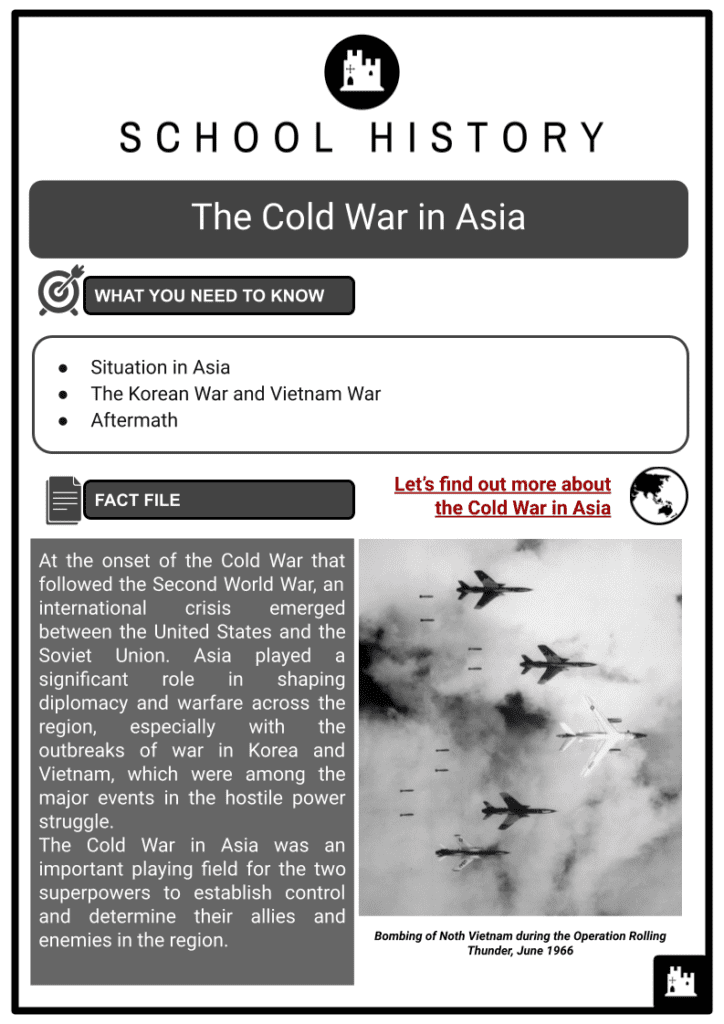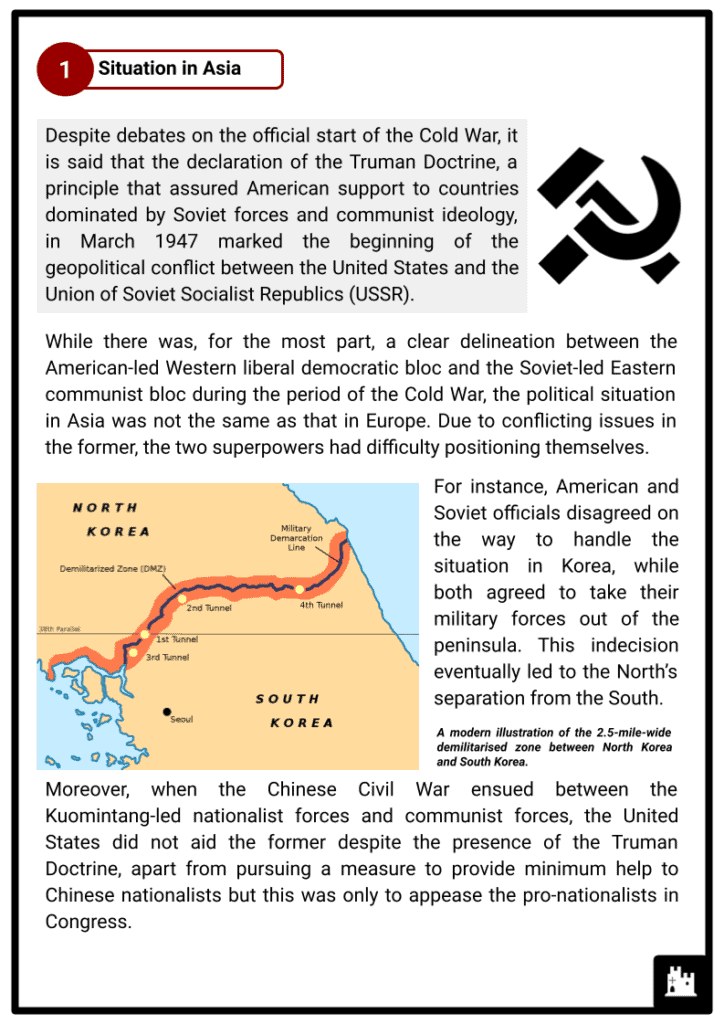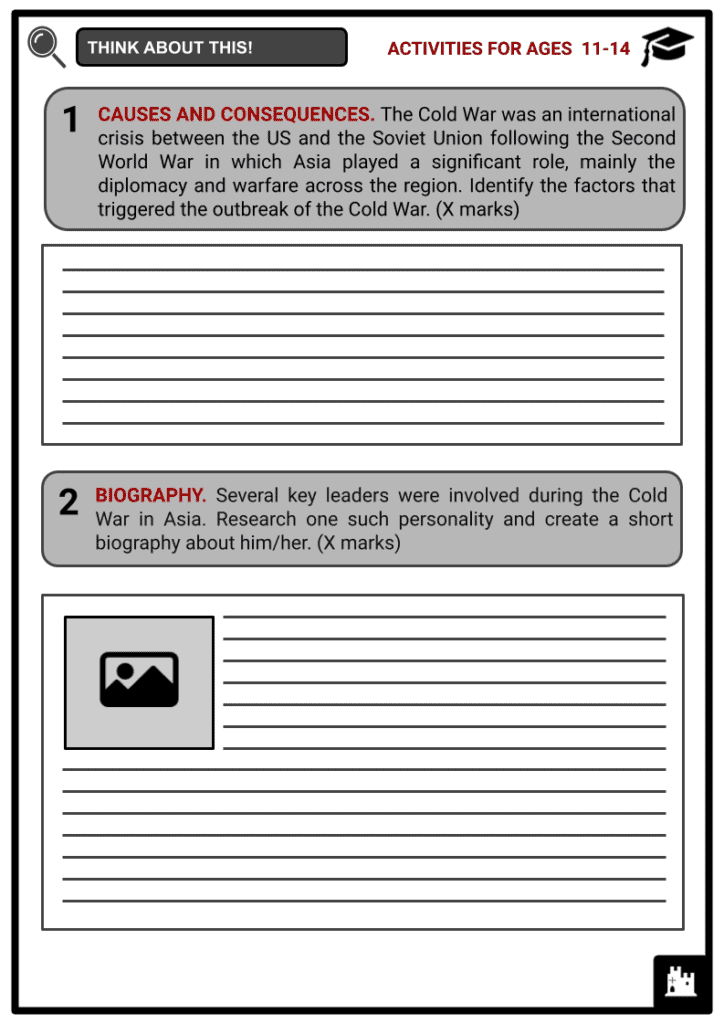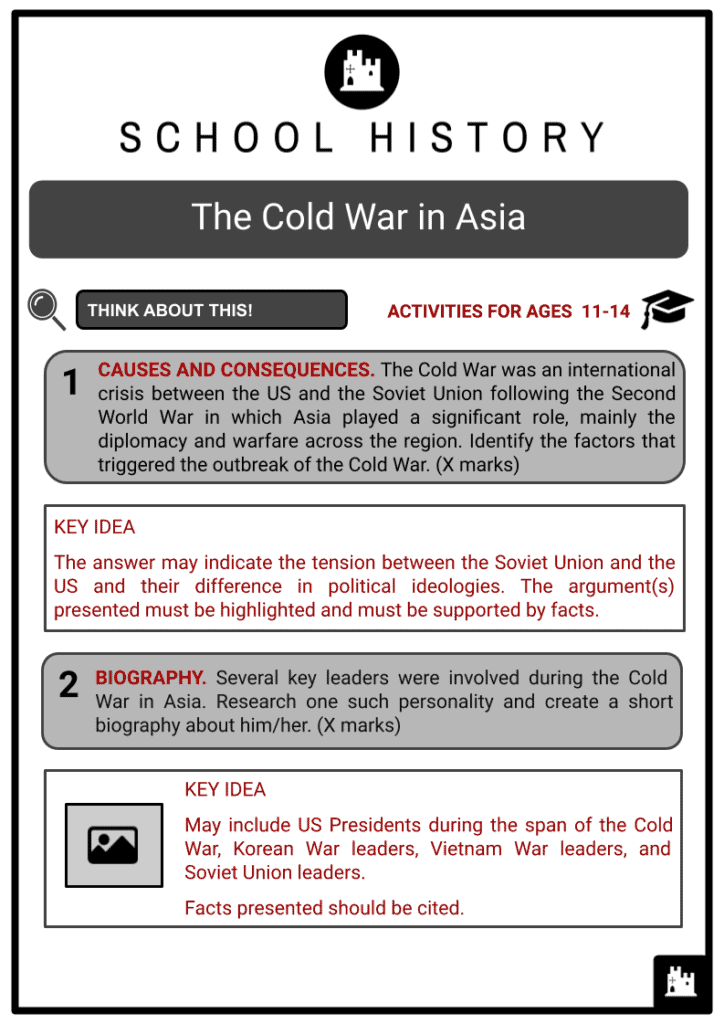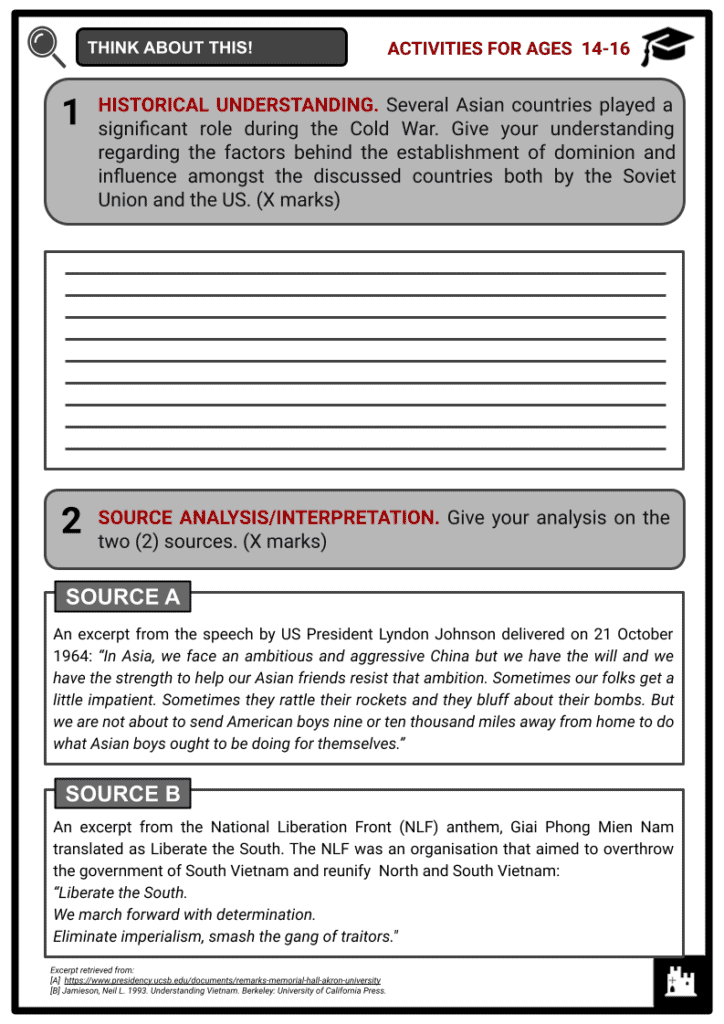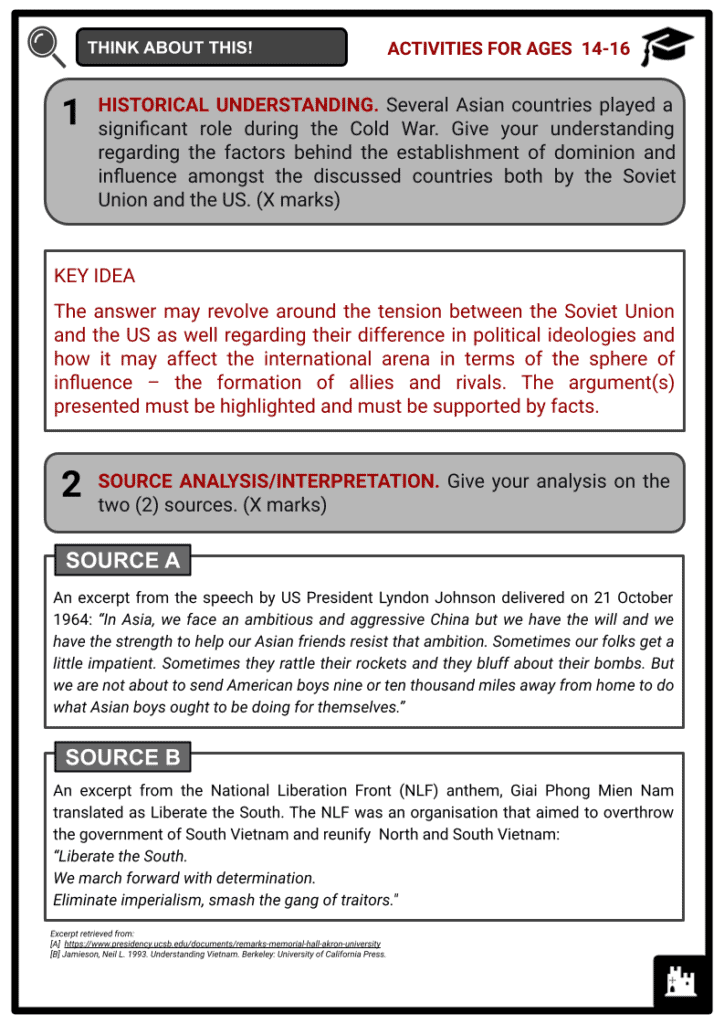Cold War in Asia Worksheets
Do you want to save dozens of hours in time? Get your evenings and weekends back? Be able to teach about the Cold War in Asia to your students?
Our worksheet bundle includes a fact file and printable worksheets and student activities. Perfect for both the classroom and homeschooling!
Summary
- Situation in Asia
- The Korean War and Vietnam War
- Aftermath
Key Facts And Information
Let’s find out more about the Cold War in Asia!
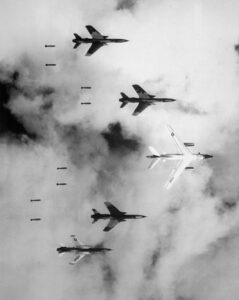
At the onset of the Cold War that followed the Second World War, an international crisis emerged between the United States and the Soviet Union. Asia played a significant role in shaping diplomacy and warfare across the region, especially with the outbreaks of war in Korea and Vietnam, which were among the major events in the hostile power struggle. The Cold War in Asia was an important playing field for the two superpowers to establish control and determine their allies and enemies in the region.
Situation in Asia
- Despite debates on the official start of the Cold War, it is said that the declaration of the Truman Doctrine, a principle that assured American support to countries dominated by Soviet forces and communist ideology, in March 1947 marked the beginning of the geopolitical conflict between the United States and the Union of Soviet Socialist Republics (USSR).
- While there was, for the most part, a clear delineation between the American-led Western liberal democratic bloc and the Soviet-led Eastern communist bloc during the period of the Cold War, the political situation in Asia was not the same as that in Europe. Due to conflicting issues in the former, the two superpowers had difficulty positioning themselves.
- For instance, American and Soviet officials disagreed on the way to handle the situation in Korea, while both agreed to take their military forces out of the peninsula. This indecision eventually led to the North’s separation from the South.
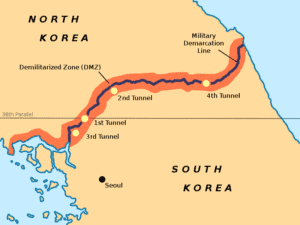
A modern illustration of the 2.5-mile-wide demilitarised zone between North Korea and South Korea. - Moreover, when the Chinese Civil War ensued between the Kuomintang-led nationalist forces and communist forces, the United States did not aid the former despite the presence of the Truman Doctrine, apart from pursuing a measure to provide minimum help to Chinese nationalists but this was only to appease the pro-nationalists in Congress.
- The occupation policy in Japan was another case in point. Although Soviet sentiment was still present in Japan, the United States managed to overhaul the occupation policy to rehabilitate the country and make it a potential American ally.
- Japan was a strategic location for the US military forces, especially Okinawa, which could provide them with a key defence base against communist forces.
- South Korea and Taiwan also belonged to the Okinawa defensive zone, yet the United States remained unclear on giving aid to South Korea in case of a communist invasion. In 1950, Truman announced that America would not meddle in Taiwan if China attacked them.
- The non-intervention in Taiwan was supposed to discourage China from forming an alliance with the Soviet Union. But the two nations had already joined forces by February 1950, thus frustrating the US.
The Korean War and Vietnam War
- The United States was far more active in intervening in the affairs of Asian countries than the Soviet Union during the Cold War, although the latter did its share of meddling in the region, most evident in the case of Afghanistan in 1979.
- From 1950 to 1953, the United States engaged in an all-out war in Korea. A year later, it was about to be involved in another war in Indochina, although it did not take shape.
- While the degree of Soviet participation in the Korean War has yet to be determined, the USSR was certainly involved when North Korea was constructing war tactics against its rival in the South. They were aiming to declare war with South Korea by June 1950 before the United States could counter their plan to achieve a fait accompli.
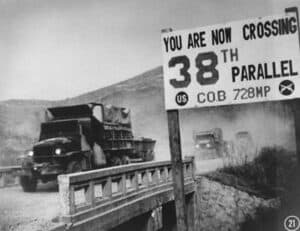
UN Military trucks crossing the 38th parallel – the boundary between North Korea and South Korea, 1950 - The Americans, meanwhile, were establishing stronger military bases in East Asia. At the time, it had already settled an agreement with South Korea to mutually provide each other with military aid, while attempting to make Japan its ally through a peace treaty. The US had also begun strengthening its military position in Okinawa.
- The outbreak of a war in Korea placed the United States at a disadvantage because they could not react passively to the overt aggression of North Korea and the Soviet Union. Doing so would weaken its prestige in Asia, especially in Japan and the Philippines, and compromise its position among European nations.
- Under the guise of a resolution issued by the United Nations Security Council, which was passed without any Soviet representative, the United States was able to legally intervene in the Korean War. When the Americans were about to win the war against the North Koreans, the Chinese aggressively engaged in the conflict, forcing the Americans to withdraw south of the peninsula.
- By the spring of 1951, the United States regained its offensive position around the 38th parallel, known as the boundary between North and South Korea.
- Consequently, the Korean War changed the attitude of the US towards Taiwan. The Americans quickly dispatched the 7th fleet to the Taiwan Strait to resist communist invasion. It was at this time that China became an active enemy of the United States. Following this, the latter gambled to reach a peace agreement with Japan and make it an ally.
- By September 1951, the San Francisco Peace Conference was held to end the Pacific War and ultimately materialise the desires of the US. This led to the US operating in Okinawa.
- The Korean War ended in an armistice agreement between the opposing sides on 27 July 1953. The Vietnam War, on the other hand, broke out on 1 November 1955. US President Dwight Eisenhower, the successor of Truman, agreed to send military forces to Vietnam as part of its anti-communist propaganda.
- But despite deploying 500,000 US military troops in South Vietnam by 1967, the Americans suffered a humiliating defeat at the hands of the Vietnamese communists.
- In June 1970, the United States was forced to withdraw its military forces from Vietnam following the repeal of the Gulf of Tonkin Resolution. The loss in Vietnam resulted in a demilitarisation sentiment in Asia.
Aftermath
- Taking advantage of the American position in Asia following the Vietnam War, the Soviet Union began to expand its influence in the region, thus increasing its financial needs, especially with the protracted war in Afghanistan.
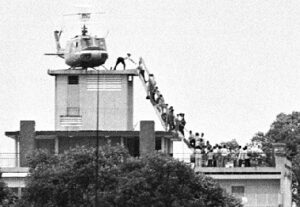
A CIA member assisting evacuees onto an Air America helicopter shortly before the event termed 'Fall of Saigon', 29 April 1975. - It did not take long before the US responded to the expansionist campaign of the Soviet Union, thereby heightening the Cold War tension. Since the 1980s, the United States had begun destabilising nations supported by the USSR. As the Soviet economy suffered, the economies of democratic countries were already recovering from the oil scarcity in the 1970s. China, meanwhile, had already been engaged in trade relations with capitalist countries. It continued to develop this market economy post-Cold War.
- Following the Gorbachev Revolution, the Soviet bloc collapsed, leading to the demise of the Soviet Union itself. North Korea and Vietnam, on the other hand, maintained their one-party system. The latter, previously at war with Cambodia, had begun to pursue a more peaceful policy in the region.
- The United States also maintained its influence in Asia even after the end of the Cold War, although the Americans severed ties with the Chinese.

